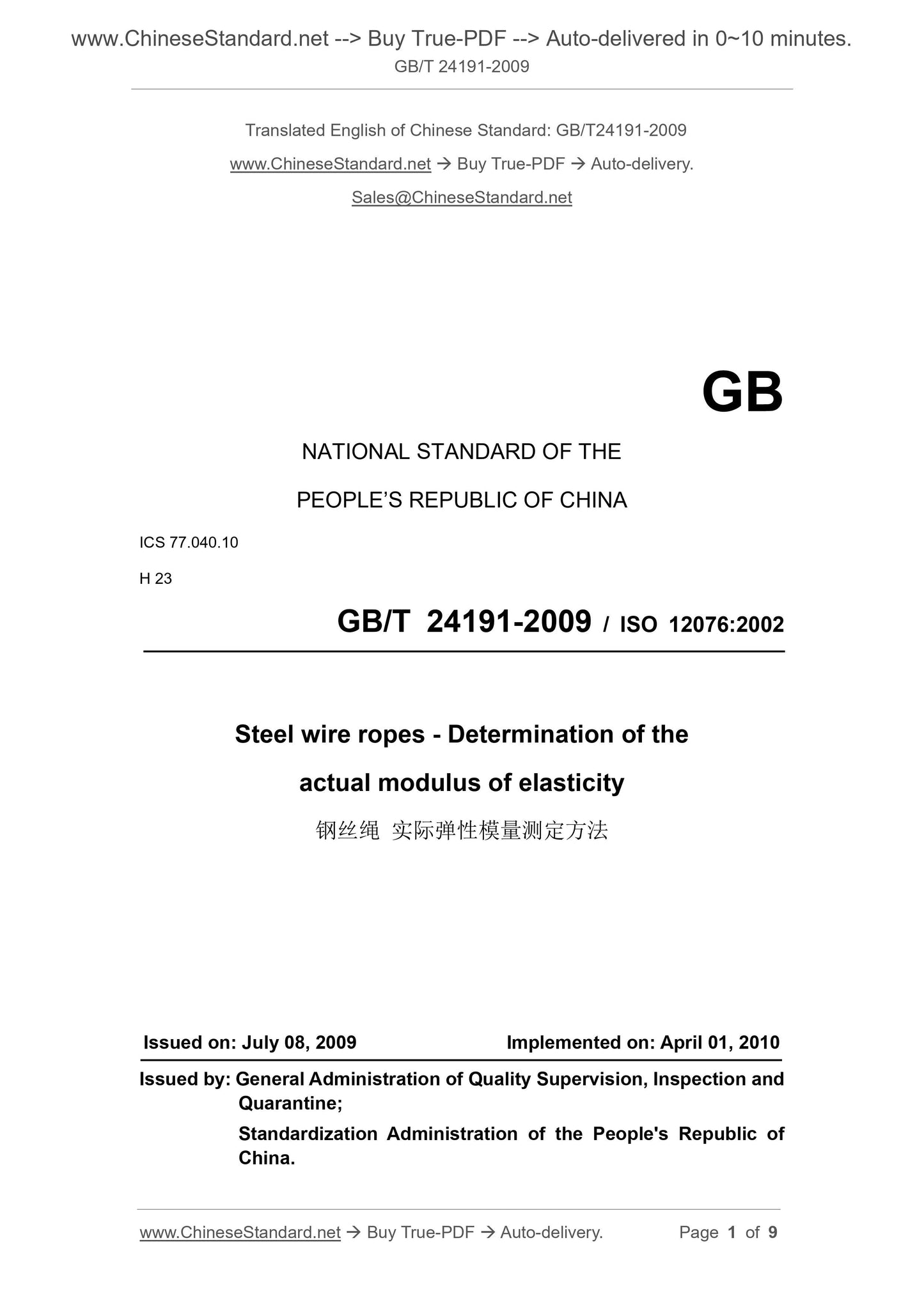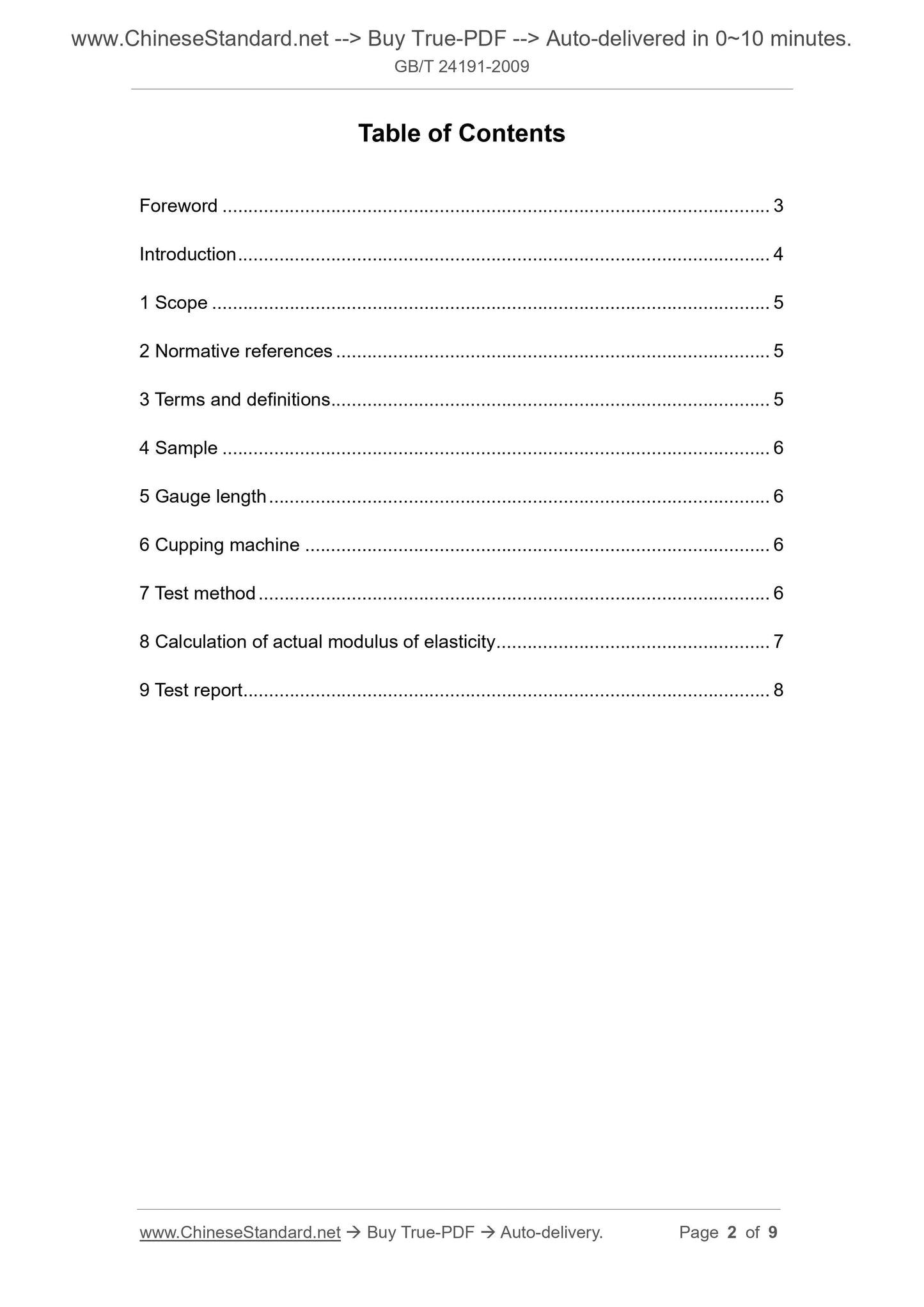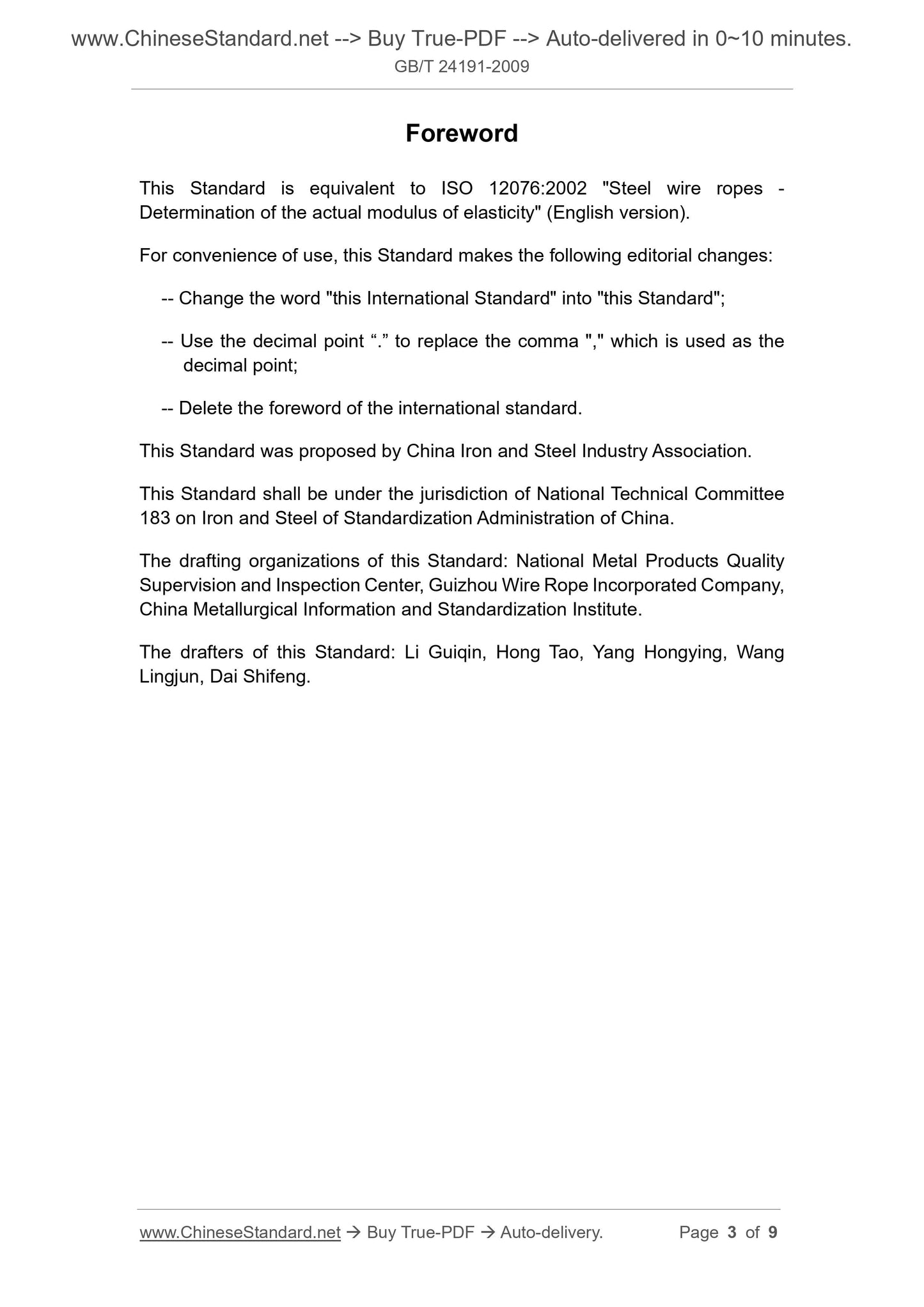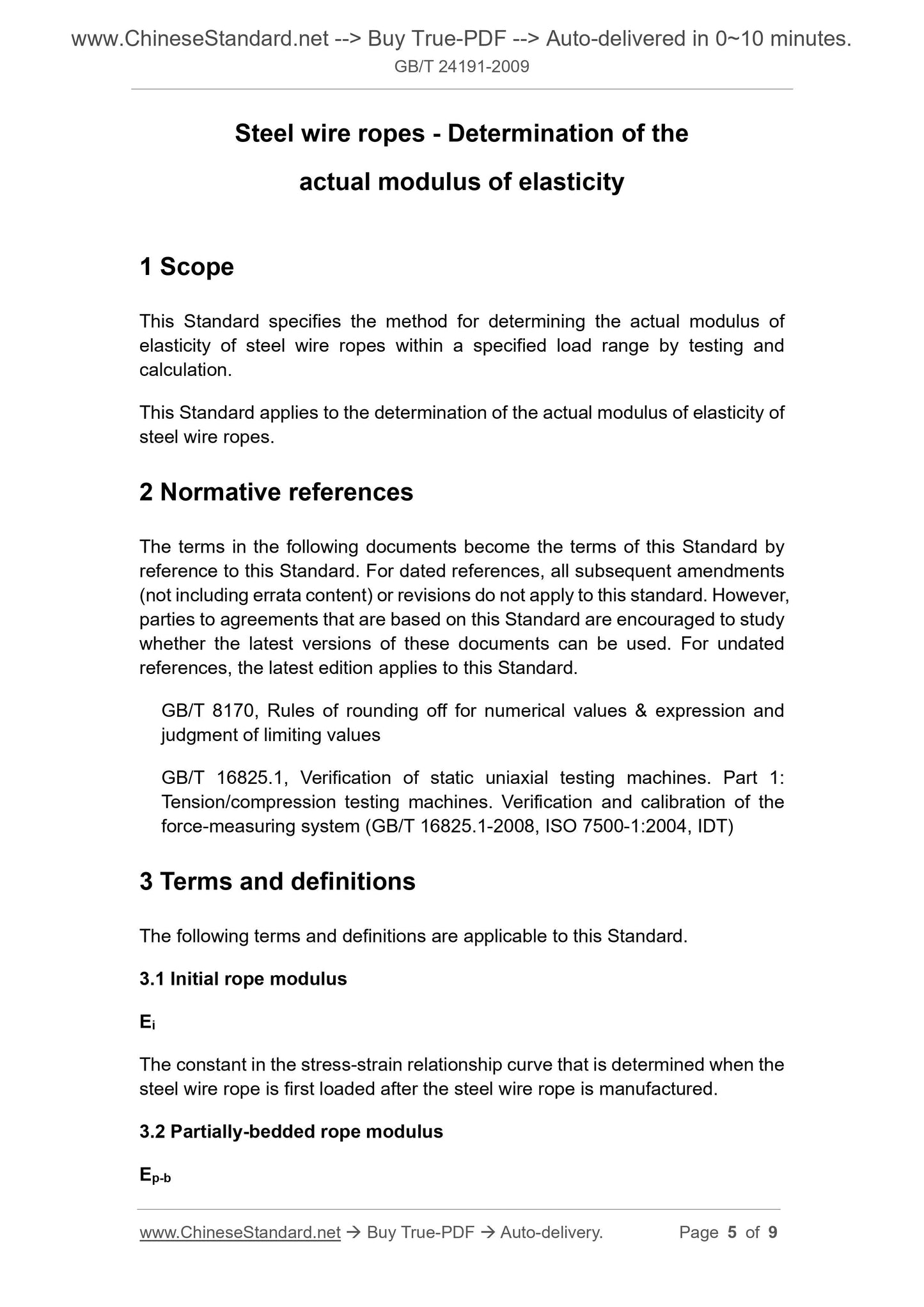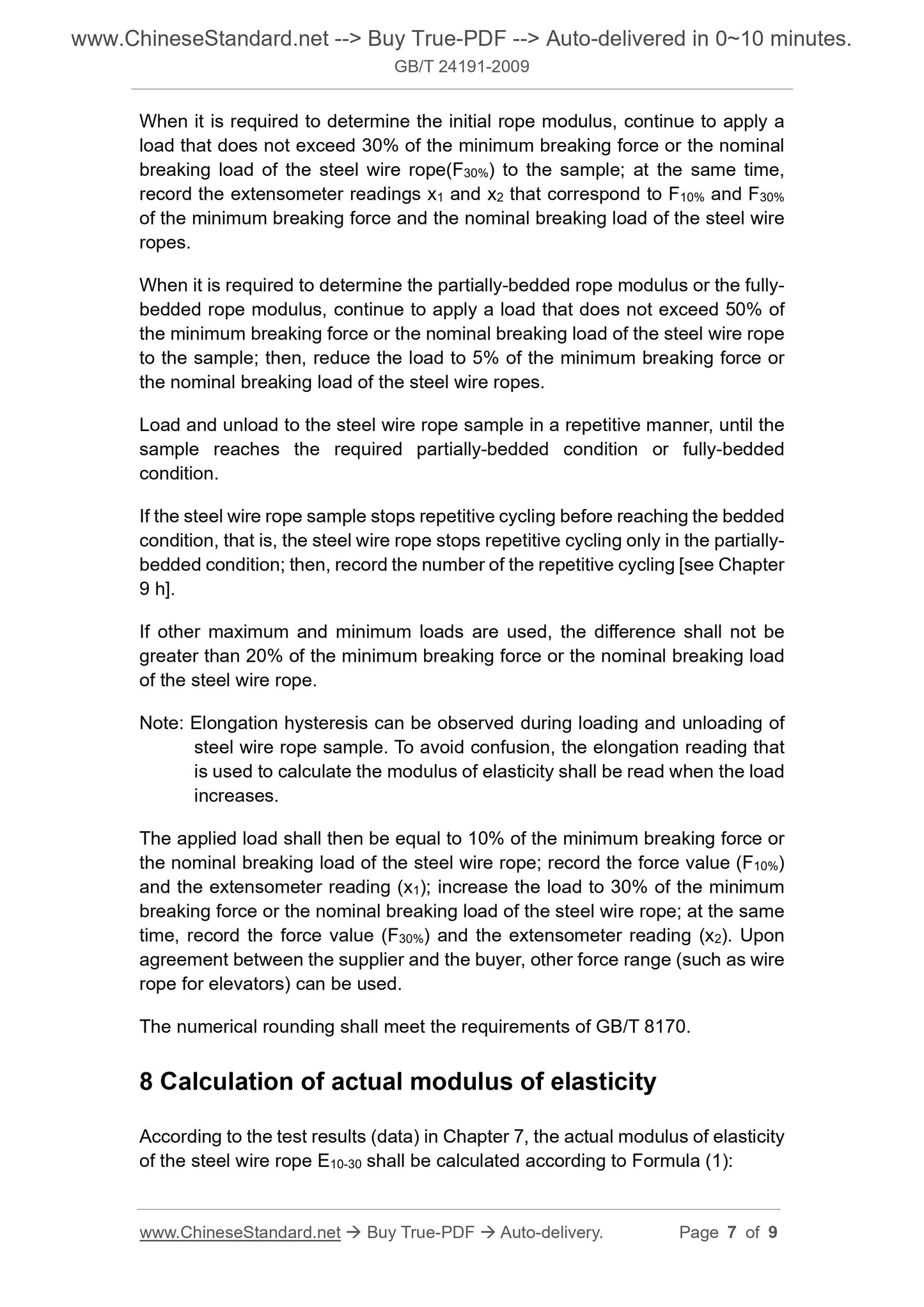1
/
of
5
www.ChineseStandard.us -- Field Test Asia Pte. Ltd.
GB/T 24191-2009 English PDF (GB/T24191-2009)
GB/T 24191-2009 English PDF (GB/T24191-2009)
Regular price
$90.00
Regular price
Sale price
$90.00
Unit price
/
per
Shipping calculated at checkout.
Couldn't load pickup availability
GB/T 24191-2009: Steel wire ropes -- Determination of the actual modulus of elasticity
Delivery: 9 seconds. Download (& Email) true-PDF + Invoice.
Get Quotation: Click GB/T 24191-2009 (Self-service in 1-minute)
Historical versions (Master-website): GB/T 24191-2009
Preview True-PDF (Reload/Scroll-down if blank)
GB/T 24191-2009
Steel wire ropes.Determination of the actual modulus of elasticity
ICS 77.040.10
H23
National Standards of People's Republic of China
GB/T 24191-2009/ISO 12076.2002
Method for determining actual elastic modulus of steel wire rope
(ISO 12076.2002, IDT)
Released on.2009-07-08
2010-04-01 implementation
General Administration of Quality Supervision, Inspection and Quarantine of the People's Republic of China
China National Standardization Administration issued
Foreword
This standard is equivalent to ISO 12076.2002 "Measurement method of actual elastic modulus of steel wire rope" (English version).
For ease of use, this standard makes the following editorial changes.
--- "This International Standard" is replaced by the word "this standard";
--- Replace the comma "," as a decimal point with a decimal point ".";
--- Remove the preface to international standards.
This standard was proposed by the China Iron and Steel Association.
This standard is under the jurisdiction of the National Steel Standardization Technical Committee.
This standard was drafted. National Metal Products Quality Supervision and Inspection Center, Guizhou Steel Rope Co., Ltd., Metallurgical Industry Information Standards Research
Research Institute.
The main drafters of this standard. Li Guiqin, Hong Tao, Yang Hongying, Wang Lingjun, Dai Shifeng.
GB/T 24191-2009/ISO 12076.2002
introduction
This standard provides a uniform test for the actual elastic modulus of wire ropes for wire rope manufacturers, suppliers and independent inspection agencies.
Test method.
The elastic modulus of the wire rope depends on the state of the wire rope, so it is necessary to know where the elastic modulus of the wire rope is intended or already
The measurement is performed in an actual state. The usual three states are.
---Initial state (ie manufacturing state);
--- Partial steady state;
--- The final state.
Wire ropes do not have a nominal modulus of elasticity, however the "approximate" modulus of elasticity of the wire rope can be determined over a specified load range.
It is referred to as the actual elastic modulus of the wire rope.
GB/T 24191-2009/ISO 12076.2002
Method for determining actual elastic modulus of steel wire rope
1 range
This standard specifies the method for determining the actual elastic modulus of a wire rope within a specified load range by testing and calculation.
This standard applies to the determination of the actual elastic modulus of wire ropes.
2 Normative references
The terms in the following documents become the terms of this standard by reference to this standard. All dated references, followed by all
Modifications (not including errata content) or revisions do not apply to this standard, however, parties to agreements based on this standard are encouraged to study
Is it possible to use the latest version of these files? For undated references, the latest edition applies to this standard.
GB/T 8170 Numerical Rounding Rules and Representation and Determination of Limit Values
GB/T 16825.1 Inspection of static single-axis testing machines - Part 1 . Examination and calibration of force measuring systems for tension and/or pressure testing machines
Standard (GB/T 16825.1-2008, ISO 7500-1..2004, IDT)
3 Terms and definitions
The following terms and definitions apply to this standard.
3.1
The constant in the stress-strain relationship curve measured when the wire rope is first loaded after the wire rope is manufactured.
3.2
The constant in the stress-strain relationship curve measured when the wire rope is in a partially stable state.
3.3
The constant in the stress-strain relationship curve measured when the wire rope is in a steady state.
3.4
The state in which the wire rope is repeatedly loaded and unloaded within two specified force values, and the elongation reading remains unchanged.
4 sample
The wire rope specimen should be sufficient to represent the characteristics of the entire wire rope and should not be defective.
The free length of the wire rope specimen at the two chucks or fixed ends of the test machine shall be at least 30 times the nominal diameter of the wire rope.
5 gauge length
When using extension timing, for wire ropes with a diameter of not more than 60 mm, the gauge length of the extensometer shall be at least the nominal diameter of the wire rope.
15 times; for wire ropes with a diameter greater than 60 mm, the gauge length of the extensometer should be at least one lay length of the wire rope, but the minimum should not be less than
900mm.
GB/T 24191-2009/ISO 12076.2002
6 tensile testing machine
The tensile testing machine shall comply with the provisions of GB/T 16825.1.
7 Test methods
When using an extensometer to measure the elongation of a specimen, first apply a minimum breaking force of the wire rope or a load of 10% of the nominal breaking load to the sample.
When it is required to determine the elastic modulus of the initial state of the wire rope, continue to apply a load to the sample to not exceed the minimum breaking force of the wire rope or
30% of the nominal breaking load (F30%), and the corresponding extension of the wire rope minimum breaking force or the nominal breaking load F10% and F30%
Count readings 狓1 and 狓2.
When it is required to determine the elastic modulus of the wire rope in a steady state or a completely stable state, continue to apply a load to the sample to not exceed the steel.
The minimum breaking force of the wire rope or 50% of the nominal breaking load, and then reducing the load to the minimum breaking force or the nominal breaking load of the wire rope
5%.
Continue to apply and remove the load on the wire rope sample in a repetitive cycle until the sample reaches the desired partial steady state or
Fully stable state.
If the repeated cycle is stopped before the wire rope sample reaches a steady state, that is, the wire rope is only in a partially stable state and stops the repeated cycle.
The number of repeated cycles should be recorded [see Chapter 9 h)].
If other maximum and minimum loads are used, the difference shall not be greater than the minimum breaking force or nominal breaking load of the wire rope.
20%.
Note. Elongation hysteresis can be observed during loading and unloading of wire rope samples. In order to avoid confusion, the elongation reading used to calculate the elastic modulus should be
Read when the load increases.
The applied load shall then be equal to 10% of the minimum breaking force or nominal breaking load of the wire rope, and the force value (F10%) and extensometer shall be recorded.
Reading (狓1); increase the load to the minimum breaking force of the wire rope or 30% of the nominal breaking load, while recording the force value (F30%) and reading the extensometer
Number (狓2). After the supply and demand sides have agreed, other force range (such as wire rope for elevators) can be used.
The numerical rounding shall comply with the provisions of GB/T 8170.
8 Calculation of actual elastic modulus
According to the test results (data) in Chapter 7, the actual elastic modulus E10-30 of the wire rope shall be calculated according to formula (1).
(F30% -F10%)
Ac(狓2-狓1)
(1)
In the formula.
E10-30---The actual elastic modulus of the wire rope, the unit is Gippa (GPa); the repaired to 3 effective figures, the repair method according to GB/T 8170
carried out;
F30%---30% wire rope minimum breaking force or nominal breaking load, the unit is kN (kN);
F10%--10% wire rope minimum breaking force or nominal breaking load, the unit is kN (kN);
Ac---calculate the cross-sectional area of the metal in square millimeters (mm2);
狓 2---30% wire rope corresponding to the minimum tensile force, the corresponding extensometer reading, the unit is mm (mm);
狓 1---10% of the wire rope corresponding to the minimum tensile force of the extensometer reading, the unit is mm (mm).
Ac is usually used to determine stress. It is a design value, the cross-sectional area of the metal calculated from the nominal diameter of a single steel wire in the wire rope.
sum.
The force value, weight and nominal metal cross-sectional area value A given in other standards for wire rope applications and working conditions may also be
Use, but should be noted in the test report.
GB/T 24191-2009/ISO 12076.2002
9 test report
The test report shall include at least the following.
a) this standard number;
b) the number of trials;
c) wire rope marking;
d) the final measured actual elastic modulus value and indicating Ei, Ep-b or Ef;
e) the range of force values applied by repeated cycles;
f) the force value corresponding to the final reading, if different from 10% and 30%;
g) calculate the cross-sectional area of the metal used for the actual elastic modulus (ie Ac or substitute A);
h) the number of repeated cycles, if only a part of the stable elastic modulus is measured;
i) The gauge length.
GB/T 24191-2009/ISO 12076.2002
GB/T 24191-2009
Steel wire ropes.Determination of the actual modulus of elasticity
ICS 77.040.10
H23
National Standards of People's Republic of China
GB/T 24191-2009/ISO 12076.2002
Method for determining actual elastic modulus of steel wire rope
(ISO 12076.2002, IDT)
Released on.2009-07-08
2010-04-01 implementation
General Administration of Quality Supervision, Inspection and Quarantine of the People's Republic of China
China National Standardization Administration issued
Foreword
This standard is equivalent to ISO 12076.2002 "Measurement method of actual elastic modulus of steel wire rope" (English version).
For ease of use, this standard makes the following editorial changes.
--- "This International Standard" is replaced by the word "this standard";
--- Replace the comma "," as a decimal point with a decimal point ".";
--- Remove the preface to international standards.
This standard was proposed by the China Iron and Steel Association.
This standard is under the jurisdiction of the National Steel Standardization Technical Committee.
This standard was drafted. National Metal Products Quality Supervision and Inspection Center, Guizhou Steel Rope Co., Ltd., Metallurgical Industry Information Standards Research
Research Institute.
The main drafters of this standard. Li Guiqin, Hong Tao, Yang Hongying, Wang Lingjun, Dai Shifeng.
GB/T 24191-2009/ISO 12076.2002
introduction
This standard provides a uniform test for the actual elastic modulus of wire ropes for wire rope manufacturers, suppliers and independent inspection agencies.
Test method.
The elastic modulus of the wire rope depends on the state of the wire rope, so it is necessary to know where the elastic modulus of the wire rope is intended or already
The measurement is performed in an actual state. The usual three states are.
---Initial state (ie manufacturing state);
--- Partial steady state;
--- The final state.
Wire ropes do not have a nominal modulus of elasticity, however the "approximate" modulus of elasticity of the wire rope can be determined over a specified load range.
It is referred to as the actual elastic modulus of the wire rope.
GB/T 24191-2009/ISO 12076.2002
Method for determining actual elastic modulus of steel wire rope
1 range
This standard specifies the method for determining the actual elastic modulus of a wire rope within a specified load range by testing and calculation.
This standard applies to the determination of the actual elastic modulus of wire ropes.
2 Normative references
The terms in the following documents become the terms of this standard by reference to this standard. All dated references, followed by all
Modifications (not including errata content) or revisions do not apply to this standard, however, parties to agreements based on this standard are encouraged to study
Is it possible to use the latest version of these files? For undated references, the latest edition applies to this standard.
GB/T 8170 Numerical Rounding Rules and Representation and Determination of Limit Values
GB/T 16825.1 Inspection of static single-axis testing machines - Part 1 . Examination and calibration of force measuring systems for tension and/or pressure testing machines
Standard (GB/T 16825.1-2008, ISO 7500-1..2004, IDT)
3 Terms and definitions
The following terms and definitions apply to this standard.
3.1
The constant in the stress-strain relationship curve measured when the wire rope is first loaded after the wire rope is manufactured.
3.2
The constant in the stress-strain relationship curve measured when the wire rope is in a partially stable state.
3.3
The constant in the stress-strain relationship curve measured when the wire rope is in a steady state.
3.4
The state in which the wire rope is repeatedly loaded and unloaded within two specified force values, and the elongation reading remains unchanged.
4 sample
The wire rope specimen should be sufficient to represent the characteristics of the entire wire rope and should not be defective.
The free length of the wire rope specimen at the two chucks or fixed ends of the test machine shall be at least 30 times the nominal diameter of the wire rope.
5 gauge length
When using extension timing, for wire ropes with a diameter of not more than 60 mm, the gauge length of the extensometer shall be at least the nominal diameter of the wire rope.
15 times; for wire ropes with a diameter greater than 60 mm, the gauge length of the extensometer should be at least one lay length of the wire rope, but the minimum should not be less than
900mm.
GB/T 24191-2009/ISO 12076.2002
6 tensile testing machine
The tensile testing machine shall comply with the provisions of GB/T 16825.1.
7 Test methods
When using an extensometer to measure the elongation of a specimen, first apply a minimum breaking force of the wire rope or a load of 10% of the nominal breaking load to the sample.
When it is required to determine the elastic modulus of the initial state of the wire rope, continue to apply a load to the sample to not exceed the minimum breaking force of the wire rope or
30% of the nominal breaking load (F30%), and the corresponding extension of the wire rope minimum breakin...
Delivery: 9 seconds. Download (& Email) true-PDF + Invoice.
Get Quotation: Click GB/T 24191-2009 (Self-service in 1-minute)
Historical versions (Master-website): GB/T 24191-2009
Preview True-PDF (Reload/Scroll-down if blank)
GB/T 24191-2009
Steel wire ropes.Determination of the actual modulus of elasticity
ICS 77.040.10
H23
National Standards of People's Republic of China
GB/T 24191-2009/ISO 12076.2002
Method for determining actual elastic modulus of steel wire rope
(ISO 12076.2002, IDT)
Released on.2009-07-08
2010-04-01 implementation
General Administration of Quality Supervision, Inspection and Quarantine of the People's Republic of China
China National Standardization Administration issued
Foreword
This standard is equivalent to ISO 12076.2002 "Measurement method of actual elastic modulus of steel wire rope" (English version).
For ease of use, this standard makes the following editorial changes.
--- "This International Standard" is replaced by the word "this standard";
--- Replace the comma "," as a decimal point with a decimal point ".";
--- Remove the preface to international standards.
This standard was proposed by the China Iron and Steel Association.
This standard is under the jurisdiction of the National Steel Standardization Technical Committee.
This standard was drafted. National Metal Products Quality Supervision and Inspection Center, Guizhou Steel Rope Co., Ltd., Metallurgical Industry Information Standards Research
Research Institute.
The main drafters of this standard. Li Guiqin, Hong Tao, Yang Hongying, Wang Lingjun, Dai Shifeng.
GB/T 24191-2009/ISO 12076.2002
introduction
This standard provides a uniform test for the actual elastic modulus of wire ropes for wire rope manufacturers, suppliers and independent inspection agencies.
Test method.
The elastic modulus of the wire rope depends on the state of the wire rope, so it is necessary to know where the elastic modulus of the wire rope is intended or already
The measurement is performed in an actual state. The usual three states are.
---Initial state (ie manufacturing state);
--- Partial steady state;
--- The final state.
Wire ropes do not have a nominal modulus of elasticity, however the "approximate" modulus of elasticity of the wire rope can be determined over a specified load range.
It is referred to as the actual elastic modulus of the wire rope.
GB/T 24191-2009/ISO 12076.2002
Method for determining actual elastic modulus of steel wire rope
1 range
This standard specifies the method for determining the actual elastic modulus of a wire rope within a specified load range by testing and calculation.
This standard applies to the determination of the actual elastic modulus of wire ropes.
2 Normative references
The terms in the following documents become the terms of this standard by reference to this standard. All dated references, followed by all
Modifications (not including errata content) or revisions do not apply to this standard, however, parties to agreements based on this standard are encouraged to study
Is it possible to use the latest version of these files? For undated references, the latest edition applies to this standard.
GB/T 8170 Numerical Rounding Rules and Representation and Determination of Limit Values
GB/T 16825.1 Inspection of static single-axis testing machines - Part 1 . Examination and calibration of force measuring systems for tension and/or pressure testing machines
Standard (GB/T 16825.1-2008, ISO 7500-1..2004, IDT)
3 Terms and definitions
The following terms and definitions apply to this standard.
3.1
The constant in the stress-strain relationship curve measured when the wire rope is first loaded after the wire rope is manufactured.
3.2
The constant in the stress-strain relationship curve measured when the wire rope is in a partially stable state.
3.3
The constant in the stress-strain relationship curve measured when the wire rope is in a steady state.
3.4
The state in which the wire rope is repeatedly loaded and unloaded within two specified force values, and the elongation reading remains unchanged.
4 sample
The wire rope specimen should be sufficient to represent the characteristics of the entire wire rope and should not be defective.
The free length of the wire rope specimen at the two chucks or fixed ends of the test machine shall be at least 30 times the nominal diameter of the wire rope.
5 gauge length
When using extension timing, for wire ropes with a diameter of not more than 60 mm, the gauge length of the extensometer shall be at least the nominal diameter of the wire rope.
15 times; for wire ropes with a diameter greater than 60 mm, the gauge length of the extensometer should be at least one lay length of the wire rope, but the minimum should not be less than
900mm.
GB/T 24191-2009/ISO 12076.2002
6 tensile testing machine
The tensile testing machine shall comply with the provisions of GB/T 16825.1.
7 Test methods
When using an extensometer to measure the elongation of a specimen, first apply a minimum breaking force of the wire rope or a load of 10% of the nominal breaking load to the sample.
When it is required to determine the elastic modulus of the initial state of the wire rope, continue to apply a load to the sample to not exceed the minimum breaking force of the wire rope or
30% of the nominal breaking load (F30%), and the corresponding extension of the wire rope minimum breaking force or the nominal breaking load F10% and F30%
Count readings 狓1 and 狓2.
When it is required to determine the elastic modulus of the wire rope in a steady state or a completely stable state, continue to apply a load to the sample to not exceed the steel.
The minimum breaking force of the wire rope or 50% of the nominal breaking load, and then reducing the load to the minimum breaking force or the nominal breaking load of the wire rope
5%.
Continue to apply and remove the load on the wire rope sample in a repetitive cycle until the sample reaches the desired partial steady state or
Fully stable state.
If the repeated cycle is stopped before the wire rope sample reaches a steady state, that is, the wire rope is only in a partially stable state and stops the repeated cycle.
The number of repeated cycles should be recorded [see Chapter 9 h)].
If other maximum and minimum loads are used, the difference shall not be greater than the minimum breaking force or nominal breaking load of the wire rope.
20%.
Note. Elongation hysteresis can be observed during loading and unloading of wire rope samples. In order to avoid confusion, the elongation reading used to calculate the elastic modulus should be
Read when the load increases.
The applied load shall then be equal to 10% of the minimum breaking force or nominal breaking load of the wire rope, and the force value (F10%) and extensometer shall be recorded.
Reading (狓1); increase the load to the minimum breaking force of the wire rope or 30% of the nominal breaking load, while recording the force value (F30%) and reading the extensometer
Number (狓2). After the supply and demand sides have agreed, other force range (such as wire rope for elevators) can be used.
The numerical rounding shall comply with the provisions of GB/T 8170.
8 Calculation of actual elastic modulus
According to the test results (data) in Chapter 7, the actual elastic modulus E10-30 of the wire rope shall be calculated according to formula (1).
(F30% -F10%)
Ac(狓2-狓1)
(1)
In the formula.
E10-30---The actual elastic modulus of the wire rope, the unit is Gippa (GPa); the repaired to 3 effective figures, the repair method according to GB/T 8170
carried out;
F30%---30% wire rope minimum breaking force or nominal breaking load, the unit is kN (kN);
F10%--10% wire rope minimum breaking force or nominal breaking load, the unit is kN (kN);
Ac---calculate the cross-sectional area of the metal in square millimeters (mm2);
狓 2---30% wire rope corresponding to the minimum tensile force, the corresponding extensometer reading, the unit is mm (mm);
狓 1---10% of the wire rope corresponding to the minimum tensile force of the extensometer reading, the unit is mm (mm).
Ac is usually used to determine stress. It is a design value, the cross-sectional area of the metal calculated from the nominal diameter of a single steel wire in the wire rope.
sum.
The force value, weight and nominal metal cross-sectional area value A given in other standards for wire rope applications and working conditions may also be
Use, but should be noted in the test report.
GB/T 24191-2009/ISO 12076.2002
9 test report
The test report shall include at least the following.
a) this standard number;
b) the number of trials;
c) wire rope marking;
d) the final measured actual elastic modulus value and indicating Ei, Ep-b or Ef;
e) the range of force values applied by repeated cycles;
f) the force value corresponding to the final reading, if different from 10% and 30%;
g) calculate the cross-sectional area of the metal used for the actual elastic modulus (ie Ac or substitute A);
h) the number of repeated cycles, if only a part of the stable elastic modulus is measured;
i) The gauge length.
GB/T 24191-2009/ISO 12076.2002
GB/T 24191-2009
Steel wire ropes.Determination of the actual modulus of elasticity
ICS 77.040.10
H23
National Standards of People's Republic of China
GB/T 24191-2009/ISO 12076.2002
Method for determining actual elastic modulus of steel wire rope
(ISO 12076.2002, IDT)
Released on.2009-07-08
2010-04-01 implementation
General Administration of Quality Supervision, Inspection and Quarantine of the People's Republic of China
China National Standardization Administration issued
Foreword
This standard is equivalent to ISO 12076.2002 "Measurement method of actual elastic modulus of steel wire rope" (English version).
For ease of use, this standard makes the following editorial changes.
--- "This International Standard" is replaced by the word "this standard";
--- Replace the comma "," as a decimal point with a decimal point ".";
--- Remove the preface to international standards.
This standard was proposed by the China Iron and Steel Association.
This standard is under the jurisdiction of the National Steel Standardization Technical Committee.
This standard was drafted. National Metal Products Quality Supervision and Inspection Center, Guizhou Steel Rope Co., Ltd., Metallurgical Industry Information Standards Research
Research Institute.
The main drafters of this standard. Li Guiqin, Hong Tao, Yang Hongying, Wang Lingjun, Dai Shifeng.
GB/T 24191-2009/ISO 12076.2002
introduction
This standard provides a uniform test for the actual elastic modulus of wire ropes for wire rope manufacturers, suppliers and independent inspection agencies.
Test method.
The elastic modulus of the wire rope depends on the state of the wire rope, so it is necessary to know where the elastic modulus of the wire rope is intended or already
The measurement is performed in an actual state. The usual three states are.
---Initial state (ie manufacturing state);
--- Partial steady state;
--- The final state.
Wire ropes do not have a nominal modulus of elasticity, however the "approximate" modulus of elasticity of the wire rope can be determined over a specified load range.
It is referred to as the actual elastic modulus of the wire rope.
GB/T 24191-2009/ISO 12076.2002
Method for determining actual elastic modulus of steel wire rope
1 range
This standard specifies the method for determining the actual elastic modulus of a wire rope within a specified load range by testing and calculation.
This standard applies to the determination of the actual elastic modulus of wire ropes.
2 Normative references
The terms in the following documents become the terms of this standard by reference to this standard. All dated references, followed by all
Modifications (not including errata content) or revisions do not apply to this standard, however, parties to agreements based on this standard are encouraged to study
Is it possible to use the latest version of these files? For undated references, the latest edition applies to this standard.
GB/T 8170 Numerical Rounding Rules and Representation and Determination of Limit Values
GB/T 16825.1 Inspection of static single-axis testing machines - Part 1 . Examination and calibration of force measuring systems for tension and/or pressure testing machines
Standard (GB/T 16825.1-2008, ISO 7500-1..2004, IDT)
3 Terms and definitions
The following terms and definitions apply to this standard.
3.1
The constant in the stress-strain relationship curve measured when the wire rope is first loaded after the wire rope is manufactured.
3.2
The constant in the stress-strain relationship curve measured when the wire rope is in a partially stable state.
3.3
The constant in the stress-strain relationship curve measured when the wire rope is in a steady state.
3.4
The state in which the wire rope is repeatedly loaded and unloaded within two specified force values, and the elongation reading remains unchanged.
4 sample
The wire rope specimen should be sufficient to represent the characteristics of the entire wire rope and should not be defective.
The free length of the wire rope specimen at the two chucks or fixed ends of the test machine shall be at least 30 times the nominal diameter of the wire rope.
5 gauge length
When using extension timing, for wire ropes with a diameter of not more than 60 mm, the gauge length of the extensometer shall be at least the nominal diameter of the wire rope.
15 times; for wire ropes with a diameter greater than 60 mm, the gauge length of the extensometer should be at least one lay length of the wire rope, but the minimum should not be less than
900mm.
GB/T 24191-2009/ISO 12076.2002
6 tensile testing machine
The tensile testing machine shall comply with the provisions of GB/T 16825.1.
7 Test methods
When using an extensometer to measure the elongation of a specimen, first apply a minimum breaking force of the wire rope or a load of 10% of the nominal breaking load to the sample.
When it is required to determine the elastic modulus of the initial state of the wire rope, continue to apply a load to the sample to not exceed the minimum breaking force of the wire rope or
30% of the nominal breaking load (F30%), and the corresponding extension of the wire rope minimum breakin...
Share
